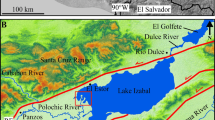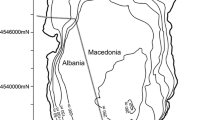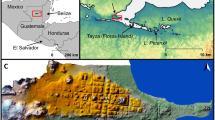Abstract
North End Lake is a polluted and eutrophic freshwater system located in Port Elizabeth, South Africa. Since the lake is expected to be used for recreational/tourist purposes by 2010, a rehabilitation program will have to be designed. For this reason, we retrieved a sediment core from the central region of the lake to decipher the effect of historical human impacts on the water body. Pre-disturbance paleolimnological inferences indicate that the lake was likely mesotrophic. After ∼1831, when sheep farming activities were undertaken in the catchment, increases in trophic state and changes in sediment composition were observed. After ∼1937, increases in trace metal levels, organic matter, spheroidal carbonaceous particles (SCP) and changes in sediment composition were recorded. The system became eutrophic as indicated by the dominance of the diatom Actinocyclus normanii, a cosmopolitan species often observed in systems where water quality has been dramatically degraded. The conditions worsened after 1986 because of the construction of a storm-water retention system, which intentionally channeled storm-water runoff into the lake. Because of this, extremely high values of fecal coliforms (i.e. 2 × 106 every 100 ml) have been measured in the water column. The paleolimnological information identified the sharp increase in organic content in the uppermost section of the core, and this could be correlated to the operation of the storm-water retention system. Therefore, as an immediate management measure, we suggest that the storm-water retention system should either no longer be utilized, or the storm-water runoff should be treated before disposal into the lake. In addition, an effective sewage system has to be constructed.




Similar content being viewed by others
References
Archibald REM (1983) The diatoms of the Sundays and Great Fish Rivers in the eastern Cape Province of South Africa. Bibliotheca Diatomologica 1:1–362
Bradbury J, Van Metre C (1997) A land-use and water-quality history of White Rock Lake reservoir, Dallas, Texas, based on paleolimnological analyses. J Paleolimnol 17:227–237
Brack K, Stevens RL (2001) Historical pollution trends in a disturbed, estuarine sedimentary environment, SW Sweden. Environ Geol 40:1017–1029
Blott SJ, Pye K (2001) Gradistat: a grain size distribution and statistics package for the analysis of unconsolidated sediment. Earth Surface Processes and Landforms 26:1237–1248
Cohen AS, Palacios-Fest MR, Msaky ES, Alin SR, McKee B, O’Reilly CN, Dettman DL, Nkotagu H, Lezzar KE (2005a) Paleolimnological investigations of anthropogenic environmental change in Lake Tanganyika: I. an introduction to the project. J Paleolimnol 34:1–18
Cohen AS, Palacios-Fest McGill J, Swarzenski PW, Verschuren D, Sinyinza R, Songori T, Kakagozo B, Syampila M, O’Reilly CN, Alin SR (2005b) Paleolimnological investigations of anthropogenic environmental change in Lake Tanganyika: IX. Asummary of paleorecords of environmental change and catchment deforestation at Lake Tanganyika and impacts ion the Lake Tanganyika ecosystem. J Paleolimnol 34:125–145
Davis A, Shokouhain M, Ni S (2001) Loading estimates of lead, copper, cadmium, and zinc in urban runnoff from specific sources. Chemosphere 44:997–1009
Dearing JA (1999) Sedimentary indicators of lake-level changes in the humid temperate zone: a critical review. J Paleolimnol 18:1–14
Flower R, Stickley C, Rose N, Peglar S, Fathy A, Appleby P (2006) Environmental changes at the desert margin: an assessment of recent paleolimnological records in Lake Qarum, middle Egypt. J Paleolimnol 35:1–24
Folk RL (1974) Petrology of sedimentary rocks. Hemphill Publishing Company Austin, Texas, pp 184
García-Rodríguez F, Mazzeo N, Sprechmann P, Metzeltin D, Sosa F, Treutler HC, Renom M, Scharf B, Gaucher C (2002) Paleolimnological assessment of human impacts in Lake Blanca, SE Uruguay. J Paleolimnol 28:457–468
Gevrey M, Rimet F, Park YS, Giraudel JL, Ector L, Lek S (2004) Water Quality Assessment Using Diatom assemblages and advanced modelling techniques. Freshwater Biol 49:208–220
Harradine M (1986) Port Elizabeth: a social chronicle to the end of 1945. EH Walton Packaging, Port Elizabeth, pp 304
Heiri O, Lotter AF, Lemcke G (2001) Loss on ignition as a method for estimating organic and carbonate content: reproducibility and comparability of the results. J Paleolimnol 25:101–110
Hutchinson SM (2005) The recent sedimentation history of Aqualate Mere (central England): assessing the potential for lake restoration. J Paleolimnol 33:205–228
Karst TL, JP Smol (2000). Paleolimnological evidence of limnetic nutrient concentration equilibrium in a shallow, macrophyte-dominated lake. Aquat Sci 62:20–38
Kaushal S, Binford MW (1999) Relationship between C:N ratios of lake sediments, organic matter sources, and historical deforestation in Lake Pleasant, Massachusetts, USA. J Paleolimnol 22:439–442
Krammer K, Lange-Bertalot H (1991) Bacillariophyceae. 3. Teil: Centrales, Fragilariaceae, Eunotiaceae. In: Ettl H, Gerloff J, Heynig H, Mollenhauer D (eds) Süsswasserflora von Mitteleuropa, Band 2/3. Gustav Fischer Verlag, Stuttgart, Jena, pp 598
le Roux L (2000) The geology of the Port Elizabeth-Uitenhage area. Council for Geoscience (Geological Survey), South Africa pp 55
Meadows ME, Baxter AJ (1999) Late Quaternary palaeoenvironments of the southwestern Cape, South Africa: a regional synthesis. Quat Int 57/58:193–206
Muri G, Wakeham SG, Rose NL (2006) Records of atmospheric delivery of pyrolysis-derived pollutants in recent mountain lake sediments of the Julian Alps (NW Slovenia). Environ Pollut 139:461–468
Noël H, Garbolino E, Brauer A, Lallier-Vergès E, de Beaulieu JL, Disnar JR (2001) Human impact and soil erosion during the last 5000 yrs as recorded in lacustrine sedimentary organic matter at Lac d’Annecy, the French Alps. J Paleolimnol 25:229–244
Pan Y, Brugam R (1997) Human disturbance and trophic status changes in Crystal Lake, McHenry County, Illinois, USA. J Paleolimnol 17:369–376
Prygiel J, Coste M (2000) Guide méthodologique pour la mise en œuvre de l’Indice Biologique Diatomées. NF T 90–354. Agences de l’Eau – Cemagref, Bordeaux, pp 134
Roach AC (2005) Assessment of metals in sediments from Lake Macquarie, New South Wales, Australia, using normalisation models and sediment quality guidelines. Mar Environ Res 59:453–472
Rose NL Boyle JF, Du Y, Yi C, Dai X, Appleby PG, Bennion H, Cai S, Yu L (2004) Sedimentary evidence for changes in the pollution status of Taihu in the Jiangsu region of eastern China. J Paleolimnol 32:41–51
Redgrave JJ (1947) Port Elizabeth in bygone days. Rustica Press, Wynberg Cape Town, pp 522
Schmidt R, Müller J, Drescher-Schneider R, Krisai R, Szeroczyńska K, Barić A (2000) Changes in lake level and trophy at Lake Vrana, a large karstic lake on the Island of Cres (Croatia), with respect to palaeoclimate and anthropogenic impacts during the last approx. 16,000 years. J Limnol 59:113–130
Smol JP (1990) Paleolimnology: recent advances and future challenges. Mem Ist Ital Idrobiol 47:253–276
Smol JP (2002) Pollution of lakes and rivers: a paleoenvironmental perspective. Oxford University Press, New York, pp 280
Smol JP (1992) Paleolimnology: an important tool for effective ecosystem management. J Aquat Eco Health 1:49–58
Smol JP (1985) The ratio of diatom frustules to chrysophycean statospores: a useful paleolimnological index. Hydrobiologia 123:199–208
Ter Braak CFJ, Šmilauer P (1998) CANOCO reference manual and user’s guide to canoco for windows: software for canonical community ordination (version 4). Microcomputer Power, Ithaca, NY, USA, pp 352
Turer DG, Maynard JB (2003) Heavy metal contamination in highway soils. Comparison of Corpus Christi, Texas and Cincinnati, Ohio shows organic matter is key to mobility. Clean Techn Environ Policy 4:235–245
Valero-Garcés BL, González-Sampériz P, Navas A, Machín J, Mata P, Delgado-Huertas A, Bao R, Moreno A, Carrión JS, Schwalb A, González-Barrios A. (2006) Human impact since medieval times and recent ecological restoration in a Mediterranean lake: the Laguna Zonãr, southern Spain. J Paleolimnol 35:441–465
van Dam H, Mertens A, Sinkeldam J (1994) A coded checklist and ecological indicator values of freshwater diatoms from the Netherlands. Neth J Aquat Ecol 28:117–133
van Metre PC, Mahler BJ (2003) The contribution of particles washed from rooftops to contaminant loading to urban streams. Chemosphere 52:1727–1741
Van Niekerk, Kleyn, Edwards–Consulting Engineers (1981) Report on the flood response of the North End Lake. Port Elizabeth Municipality Report. 10 pp
Walling DE (1999) Linking land use, erosion and sediment yields in river basins. Hydrobiologia 410:223–240
Weichers HNS, Freeman MJ, Howard MR (1996) The Management of Urban Impoundments in South Africa, Volume 1: Status Quo Report. Report No. TT 77/96. Water Research Commission, Pretoria, 89 pp
Wessels M, Mohaupt K, Kümmerlin R, Lenhard A (1999) Reconstructing past eutrophication trends from diatoms and biogenic silica in the sediment and the pelagic zone of Lake Constance, Germany. J Paleolimnol 21:171–192
Witkowski A, Lange-Bertalot H, Metzeltin D (2000) Diatom flora of marine coasts I. In Lange-Bertalot H (ed) Iconographia diatomologica, vol 7. Königstein, 925 pp
Zalat A, Vildary SS (2005) Distribution of diatom assemblages and their relationship to environmental variables in the surface sediments of three northern Egyptian lakes. J Paleolimnol 34:159–174
Acknowledgements
This project was funded by the National Research Foundation. Len Compton built the piston-corer used in this study. Roy Wilmot is thanked for providing us with information on the history of the lake. The Nelson Mandela Metropolitan Municipality provided us with limnological information. Joy Kritzinger is thanked for being a tough secretary. Catherine Dalton, John Smol and an anonymous reviewer provided helpful comments that improved this paper. This paper is dedicated to the loving memory of Felipe García-Urioste (1938–2006).
Author information
Authors and Affiliations
Corresponding author
Rights and permissions
About this article
Cite this article
García-Rodríguez, F., Anderson, C.R. & Adams, J.B. Paleolimnological assessment of human impacts on an urban South African lake. J Paleolimnol 38, 297–308 (2007). https://doi.org/10.1007/s10933-006-9076-8
Received:
Accepted:
Published:
Issue Date:
DOI: https://doi.org/10.1007/s10933-006-9076-8




